
The Story of Earth
- The fist 4.5B years, from stardust to living planet -
Cat: SCI
Pub: 2012
#: 1621b
Robert M. Hazen
16y12u/18227r
Résumé
Remarks
>Top 0. Introduction:
- One of the most arresting images of 20C is a photo of Earthrise.
- Earth is the only known planet with oceans of water, with an atmosphere rich in oxygen, with life.
- Earth appears alone, small, and vulnerable but also beautiful.
- Eratosthenes of Cyrene (276-194BC): Earth must be a sphere; its circumference about 40,075 km.
- Our knowledge of Earth has increased since the dawn of humankind.
- Earth has always been a restless, evolving planet.
- This book is to convey Earth's long history of change; its vibrant story embraces a succession of transformational events.
0. 序文:
- 地球の出:
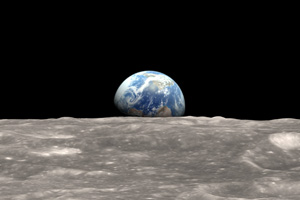
>Top 1. Birth: the formation of Earth:
- Our Solar System:
- a relative newcomer to the cosmos; 4.567B years old.
- the Big Bang: 13.7B years ago;
- the moment of creation remains the most elusive; singularity - a transformation from nothing to something.
- Nuclear fusion process:
- Fe has he lowest energy of any atomic nucleus; ultimate nuclear ash.
- the star sustains a stable equilibrium; gravity pulling mass toward the center and nuclear reactions pushing mass outward.
- The entire star collapsed inward; it rebounded of itself and exploded in the first supernova.
- The birth of chemistry:
- H2 atoms just as inexorably produced the first stars.
- When the first big stars exploded, cosmic novelty ensued.
- C, O, N, P, S were specially abundant - the elements of life.
- Mg, Si, Fe, Al, Ca dominate the compositions of common rocks.
- Isolated atomic nuclei almost never interact, except in the ultimate pressure-cooker environments of stellar interiors.
- Electrons from on atom are constantly bumping into the electrons of adjacent atoms. (Chemical reactions)
- H2 molecules; they pool their resources to form a molecule.
- H2O, N2, NH3, CH4, CO, CO2 molecules enriched the space round supernove.
- The first minerals could have formed where density of mineral-forming elements were high-enough, but temperature cool enough to arrange in little crystals; tiny crystallites of pure carbon - diamond and graphite were probably the first minerals in the universe.
- Soon joined by other high temperature solids including Mg, Ca, Si, N, and O.
- Corundum of Al, O; is valued in its richly colored varieties, ruby and sapphire.
- Mg silicated olivine.
- Nothing happens only once in our universe (except for the Big Bang)
- Remnants of the former stellar generations inexorably seeded new populations of stars by forming new nebulas.
- Each new nebula was more Fe rich, and a little poorer in hydrogen.
- Cosmic Clues:
- The Solar System:
- One striking feature is that all the planets and moons orbit the Sun on the same lane and in the same direction.
- Earlier in the history of the Solar System intense solar wind blew leftover H2 and He far out to the colder reams; formation of out gas giants.
- The coaser minearal-rich grains of dust that remained close to the hot central star quickly clumped together to form the rocky inner planet.
- >Top The earth is constantly being peppered by meteorite.
- Chondrules: the blast furnace effect melted the dusty disk into clots of small, sticky rock droplet, called chondrules.
- The continent of Antarctica's vast plains; where it never snow.
- A single lunar meterorite found somewhere in the sands of North Africa early in 21C.
- 250 different minerals have been found in all meteorites.
- The Sun:
- is a modest sort of star.
- 10 times the mass of our Sun might last less than a tenth as long.; conversely a red dwarf star tenth the Sun's mass will last more than 10 times longer.
- Io, it completes a full orbit once every 41 hours.
- 2005.1.14: European Huygens touched down Titan.
- Deep Time:
- All the recorded human history is much less than 4.5B minutes. (1year=365.25 days=525,960 minutes=31,557,600 seconds)
1. 地球の生成:
- 太陽系の歴史: 4.567B years
- ビックバン以降: 13.7B years
- 核融合
- 化学の誕生
- H2以降
- 化学変化
- 分子の生成
- 最初の鉱物
- 隕石:
- chondrite: 球粒隕石
- pallasite: cositing equally Fe and olivine.
- 水・氷のある衛星等(12):
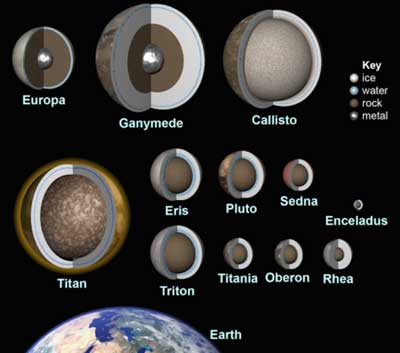
- Jupiter: Europa, Ganymede, Callisto
- Satern; Titan, Rhea, Enceladus
- Uranus: Titania, Oberon,
- Neptune: Triton
- Pluto:
- Eris, Sedna
>Top 2. The Big Thwack: The formation of the Moon
- Spanning the billion of years before Earth's formation.
- How the planetary systems evolve:
- Changes are often gradual, but sudden violent and irreversible events can forever alter a world in minutes.
- Earth formed relative quickly, in no more than a million years.
- Once every few thousand years, a miniplanet smacked into the proto-Earth and was swallowed whole; blasting vaporized rocks into orbit and disrupting the entire surface into a molten, red-hod rocky slush.
- Following each great impact, Earth's airless surface quickly cooled and blackened again.
- Strange Moon:
- Earth's Moon is relatively huge compared with the planet it orbits.; more than a quarter of Earth's diameter and about 1/8 of its mass.
- Prior to Apollo Moon landings in 1969:
- Three prime hypothesis:
- Mother Earth' birthing: by George Darwin; earth flung off a glob of magma from the surface into orbit.
- Capture theory; larger Earth captured smaller Moon.
- Co-accretion theory; Moon formed more or less in its present location from large cloud of leftover debris that remained in orbit around the Earth.
- Touchdown on the Moon:
- >Top Oxygen isotopes:
Ratio of O-16 to O-18 varied from planet to planet and is very sensitive to the planet's distance from the Sun when it formed.
- Moon and Earth do match up in terms of oxygen isotopes.
- O-17 and O-18 rise quadratically with time because they are secondary isotopes. (O-18 is abundant in He-rich zones, while O-16 & O-17 require H burning.)
- Moon differs from Earth in that its density is much lower; Earth's core holds a third of its mass, but the Moon is less than 3% of its mass
- Moon rocks contain almost no traces of the most volatile elements - tend to vaporize the moment things get warm; N, C, S, H so common at Earth surface are missing from Moon dust; no water-bearing minerals (clays and micas) have been brought back from the Apollo mission.
- Big Thwack model:
- >Top About 4.5B years ago, black proto-Earth and a slightly smaller planet-size (dubbed Theia) - perhaps 2-3 times the size of Mars (a third of Earth's mass).
- No two planets can share the same orbit. Eventually they will collide.
- By computer simulations: most combinations simply do no work; no Moon forms. But a few models are surprisingly successful and product an Earth-Moon system.
- This theory explains all the major clues better than any other model;
- The Moon lacks an iron core because most of Theia's iron would up inside Earth.
- The Moon lacks volatiles because Theia's volatiles were blasted away during the impact.
- One side of the Moon always faced Earth because the angular momentum of Earth and Theia were coupled into one spinning system.
- also helps to explain Earth's anomalous axial tilt (23 degrees).
- Big Thwack events are common; which explain why Venus rotates the wrong way on its axis and caused Uranus to rotate on its side.
- Moon has moved farther away; 3.82 cm per year; play the tape backward and it points to a radically different situation 4.5B years ago.
- Early Moon:
- was a violent body of intense volcanism; its surface would have appeared black, with glowing red magma-filled cracks and volcanic basins visible from Earth.
- Full Moon was equally dramatic, the surface reflecting hundreds of times more sunlight than in our modern ear; easily read a book under its brilliant illumination.
- 4.5B years ago, the Moon only 24,000 km from Earth surface, everything was turning ridiculously fast; Earth rotated on its axis once every 5 hours. (Sun rose every five hours!)
- Corals in Devonian Period (400 ma) display more than 400 daily lines per year.
- tidal rhythmites from 900 ma at Big Cottonwood Canyon, Utah; Earth days were only 18.9 hours long, and 464 days every year.
- Young Moon exerted tremendous tidal forces on Earth's rocks, even as Earth exerted an equal and opposite gravitation force on the largely molten lunar landscape
2. 大衝突: 月の生成
- 地球の月は、惑星に比べ比較的大きい

- 月生成の3仮説:
- 地球から誕生: (子供説)
- 地球により捕獲: (養子説)
- 同時に生成: (双子説)
- 1969 月着陸以降新事実判明
- 酸素同位体: O-16/-17/-18
- 地球と月は同位体比が同じ
- 地核のサイズが異なる
- 月の岩石: 揮発性物質の痕跡なし。
N, C, S, Hが欠落
- 大衝突モデル:
- 原始地球と地球の1/3程度の小惑星(Theia)とが衝突。
- 鉄コアの大きさ
- 揮発物質の欠如
- 同じ月面を地球に向けている
- 月は地球から遠ざかりつつある
- 原始月:

-
- 4.5B年前。地表より24,000kmの距離
- 地球の自転約5時間
- デボン紀(4億年前)のサンゴの年輪は、年400日であった
- ユタ州の堆積岩rhythmiteは、464日/年を記録
- 月による潮汐力巨大
>Top 3. Black Earth: The First Basalt Crust:
- Earth's Age: 50 - 100M years.
- Had the impact been dead center, much more of Theia's mass would have wound up as part of Earth.; merged into one larger moonless world.
- Our Solar System's history is a litany of thwacks and near-misses.
- The asteroid that helped to kill off the dinosaurs might just as well have been off the mark.
- Earth would have taken a different path.
- Perhaps big-brained birds would have become intelligent, flying toolmakers.
- >Top Hadean Eon: first 500M years.
- Sulfurous volcanic exhalations, rivers of glowing lava.
- Steady bombardment of asteroids and comets.
- Of Earth's origin, we have rich record of the Solar System.
- Nothing known on Earth itself; not a fragment of rock or a grain of mineral.
- Surveys of the lunar surface might be enough to find errant Hadean stones.
- Early evolution of Earth:
- Cosmochemistry (making elements) & Petrochemistry (making rocks:
- stellar production of all the heavier elements;
- >Top The Big Six elements: O, Si, Al, Mg, Ca, Fe; 98% of Earth's mass.
- O is Earth's master electron acceptor;
- 99.9999 % is locked into rocks and minerals.
- SiO2 (silicate): 2/3 of the atoms are O.
- Si is major electron donor; Si 1/4 in Earth's crust and mantle.
- Ca, Mg, Al play key structural roles in the most common silicate rocks in crust and mantle.
- Fe is by far the most versatile; shares 1/10 in crus and mantle.; Earth's core is more than 90% Fe.
- Earth's most abundant minerals; olivine, garnet, pyroxene, and mica:
- have variants that display pretty much any Mg-Fe ratio, from colorless version (100% Mg) with dark-hued varieties (100% Fe2+)
- Fe is not restricted to +2 state, however, in the presence of lots of electron acceptors, it readily gives up a the rid electron to become a +3 iron.
- The minerals garnet, amphibole, and mica display every imaginable Al-Fe ration, with Fe-rich varieties presenting as red rather than green.
- Fe metal is a vast collection of Fe atoms that collectively share such delocalized electrons.; (shared electrons)
- make excellent conductors of electricity.
- the electron sea surrounding the atoms can be folded and twisted without losing its collective strength.
- Metallic Al, Mg, and Si are modern marvels of the chemical industry.
- their metallic states almost never form in nature.
- Fe is less committed to O; Fe link to other electron acceptors, notably S.
- FeS is pyrite.
- Fe readily forms a dense metal that sinks to the center of planets.
- Molten Earth:
- The big six chemical behaviors set our planet on an irreversible course of transformation into the world we inhabit today.
- Magma ocean; imagine again the violent years following the Moon forming impact.
- molten silicate rain at temperatures of thousands of degrees.
- super greenhouse state; high radioactive elements of Al, W, U, Th, K continued to add even more heat. Volcanic release of CO2, may have amplified these effects.; 100 years or 100K years the molten state prevailed.
- Conduction: transfer heat locally to an adjacent object.
- Convection; hot atoms move thermal energy wholesale, is a better planetary choice fro cooling.
- Radiation; travels 299,792 m/s through a vacuum. Any hot object radiates heat to its cooler surroundings in the from of infrared radiation.
- Conduction is swifter, convection more vigorous, and radiation much more intense if the temperature differences are large.
- First Rocks:
- Earth's prodigious heat loss to space, the formation of a rocky crust was inevitable.
- the molten surface cooled just enough for the first crystals to form.
- On both Earth and the Moon, during that long-ago cooling period, beautiful tiny green crystals began to grow in the magma; olivine is typically denser than the liquid in which it grows, so those first crystals began to sink, forming a stunning green rock called dunite.
- The remaining hot melts changed composition; depleted in Mg; they became more concentrated in Ca and Al.
- >Top On the Moon:
- a second mineral started to from.; anorthite (CaAl2Si2O8) began to crystallize alongside olivine. Anorthite is less dense than its host liquid, so it tends to float; floating feldspar mountain; dominate 65% of the Moon's reflective silvery face.
- Apollo samples reveal a range of 3.9-4.5B years, shortly after the Big Thwack.
- >Top On the Earth:
- Mg-rich peridotite: Earth's first peridotite crust; earliest rocks featured olivine and pyroxene greenish-black rock.
- Earth's earliest rocks predominantly featured olivine and pyroxene (called peridotite).
- Peridotite is relatively rare at surface today; cooling peridotite is denser than the hot magma ocean.
- Core Truths:
- Deeper in the mantle (80-160 km beneath the crust); cooling and crystallization must have proceeded in a similar fashion, albeit more slowly.
- Separation of crystals from melts by sinking and floating probably played a significant role.
- Lower-density crust, higher-density mantle, and thicker, really dense metallic core.
- Upper mantle (- 400km); forces atoms in olivine to pack into a denser silicate crystal (wadsleyite, Mg2SiO4)
- Lower mantle (400km - ); hundreds of thousands of time the surface pressure; Si-O bonds an even denser; perovskite.
- The core-mantle boundary: expected strong echo as sharp as that between air and water.; D'' (D double prime) layer
- All mantle minerals float on the dense core like corks on water.
- Core:
- Fe-rich core: 3,200km in diameter.; 5,500ºC; 1M times atm.
- Earth's magnetoshpere provides an invisible deflector shield to the solar wind; prerequisite for the origins and survival of life.
- >Top Basalt:
- Black basalt dominates the near-surface rocks of every terrestrial planet.
- Mercury is mostly basalt. Mountainous surface of Venus and weathered red surface of Mars. The Moon's darkly splotched mares (seas) contrast to the paler gray anorthosite highlands.
- Essential mineral ingredients of basalt:
- Feldspar: Al-bearing mineral in terrestrial panels and moons.
- Pyroxene: is one of a handful of common that can incorporate all of the big six elements.
- >Top Peridotite:
Earth's magma ocean cooled; olivine formed first, then a little bit of anorthite, and finally a lot of pyroxene.; the resulting Mg silicate rock was peridotite, which formed much of the upper mantle.
- Red-hot peridotite much is not nearly strong enough to support a mountain.
- But tough basalt, with its relatively low density, is different; the average density of basalt is more than 10% lower than that of peridotite.
- A floating mass of basalt 16km thick above the magma ocean.
- Hostile World:
- Meteors incessantly bombard the surface.
- No trace of life-supporting O2
- Receding Moon continued to play a major role in shaping the crust.
- Earth's insanely rapid rotation; 5h/d.
3. 黒い地球: 最初の玄武岩地殻
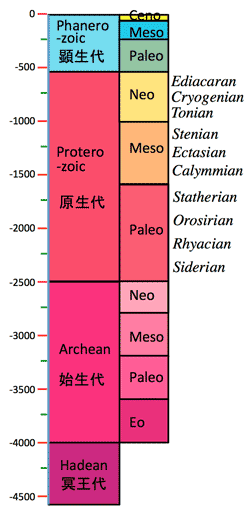
- Abundance of elements in crust (% in mass): O, Si, Al, Fe, Ca, Na, K, Mg
- Felspar (長石):
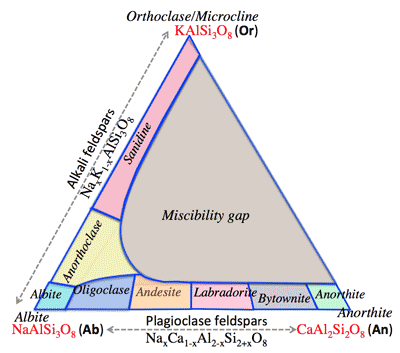
- Pyroxene (輝石):XY(Si, Al)2O6

- Olivine (橄欖岩): (Mg, Fe)2SiO4
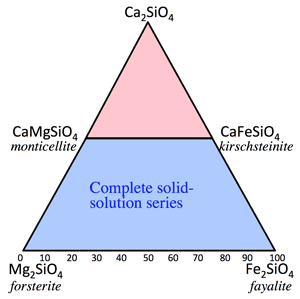
- Igneous Rock: 火成岩
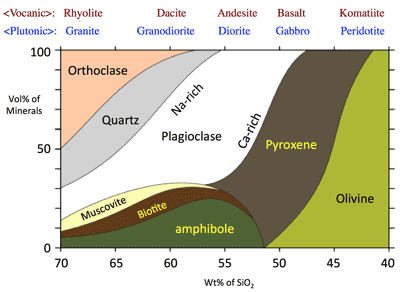
- >Top Atomic Ion Size:

- Olivine: (Mg-Fe) SiO4; forsterite - fayalite
- Garnet: A3B2 (SiO4)3; A2+, B3+
- Pyroxene: AB (Si, Al)2O6; A2+, B3+
- Mica (muscovite): KAl2□AlSi3O10(OH)2
- Mica (aragonite): NaAl2□AlSi3O10(OH)2
- Mica (phlogopite):
KMg3AlSi3O10(OH)2
>Top 4. Blue Earth: The Formation of the Oceans
- Haden time; 'what we know we don't know.
- even more tantalizing is the prospect of discovering aspects of 'we didn't know we didn't know.'
- The black Earth could not remain black for long.
- >Top Five principals:
- N, C, S, H, O: Global-scale volcanism spewed; N, CO2, S, and H2O took the leading roles as Earth's mobile gaseous components.
- All became concentrated in the most primitive C-rich chondrite meteorites more than 4.56B years ago.
- Water became the chief architect of Earth's solid surface.
- Oceans today represent only about 002% of Earth's total mass.
- Atmosphere is no more than 1 ppm.
- Chondrites
- Carbon Content of primitive chondrites average more than 3%.; Earth now add up to less than 0.1%,
- Water content is much greater than Earth's modern average - perhaps a 100 times more.
- Most of Earth's volatiles must have been lost to space or deeply buried.
- Nitrogen: plays almost no role in rock formation, and tends to concentrate in the atmosphere.
- since the rise of life has N-cycle had much effect on Earth's outer layers.
- Carbon and Sulfur would come into much greater prominence 1-2B years into Earth's existence, when life and O2-rich atmosphere transformed the surface realm.
- >Top Water has been central to Earth's story from the get-go.
- unique chemical properties of Hydrogen oxide.
- Mickey Mouse's ears like V shape; Polar molecule; O atoms a slight negative electrical charge, while 2H positive charge.
- Sensitive properties; super solvent; the oceans have become rich in almost all the chemical elements.
- an ideal medium for the origins and evolution of life; perhaps all life in the cosmos, depends on water.
- The polarity of water molecules cases to bond strongly to one another; ice is an strong molecular solid.
- High surface tension; small insects literally to walk on water.
- Capillary action; caused water to rise through the stems of vascular plants.
- Rounded raindrops, pulled together by strong mutual attraction of water molecules; maintaining Earth's rapid water cycle. Nonpolar volatile molecules like CH3 or CO2 can't form such droplets; just float as an ultra fine, pervasive mist; so rain would be unknown on a planet dominated by those atmospheric gases.
- Liquid water is about 10% denser than solid ice; in almost every known chemical compounds, the sold sinks in its liquid.; a layer on a frozen river or stream, or a giant iceberg floats.
- >Top Hydronium:
'Pure' water is its lack of purity.; water is never made entirely of H2O molecules.; a small fraction of those three-atom units inevitably splits apart into H+ ions and OH- ions;; or produce H3O- hydronium ions.
- pH and salinity of Earth's earliest oceans remains a hotly debated matter.
- Water, Water Everywhere:
- Mercury;in frigid polar craters.
- Mars; in the northern polar regions and subsurface permafrost or groundwater in deeper warm zones.; vast extent of water on Mars been confirmed.
- Mars may have been a blue, life-giving planet many millions of years before Earth.
- Moon; deep interior holds prodigious amounts of unseen water.
- Oxygen isotopes:
- The ratio of O-16 and O-18 in a zircon crystal points to the temperature at which it grew.
- Water lowers the temperature at which crystals grow.
- Earth's surface tend to be more enriched in O-18, so zircon crystals with extremely rich O-18 contents have been interpreted as having interacted with surface water.
- Zircon crystals from jack Hills of Australia; 4.4B years ago; when Earth was about 150M years old, the surface was relatively cool and wet; hence there were oceans.
- 100M years after the Big Thwack, Earth had become a brilliant blue water world with a mile-deep encircling ocean.
- the hot early ocean quickly became far saltier than today.; as much as twice that of the modern world.; Fe, Mg, and Ca that dominate basalt would have been present in higher concentrations as well.
- whether the Hadean ocean was acidic or basic.
- CO2 content of the early atmosphere was 400 ppm (278ppm before Industrial Revolution).
- More CO2 in the air meant a lo more Co2 in the water; H2CO3, or H3O+, or HCO3- turns the oceans more acidic, perhaps to PH as low as 5.5.
- Such acidic ocean conditions accelerated the weathering of basalt and other rocks.
- >Top The Faint Sun:
- Youthful Sun of 4.4B years ago was 25-30% less bright than it is today.; have remained faint fro at least another 1.5B years.
- If today's Sun were suddenly to dim, Earth would quickly enter a a devastating icebox phase.
- How could the early ocean have been liquid?
- Much fainter Sun was compensated for by a much hotter Earth.
- More than 10 times the pressure of our present atmosphere (the same high CO2 concentrations); may have acidified the ocean and increased its salinity.
- Black Earth absorbed a far higher percentage of Sun's energy.
- Large amount of methane gas in the early atmosphere.; where ultraviolet radiation would have triggered the synthesis of organic molecules; Blue Earth into a distinctly orange world.
4. 青い地球: 大洋の生成
- ヘイデン (冥王代)
- 5つの基本元素:
N, C, S, H, O
- 水=酸化水素
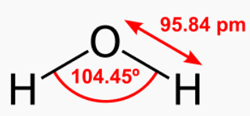
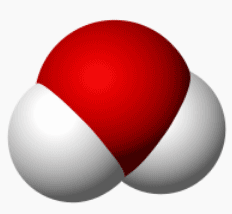
- ヒドロニウム
- 酸素の同位体:
O-16/O-18比率
- 弱々しい太陽:
輝度 20-30%減
>Top 5. Gray Earth: The First Granite Crust:
- Earth today is a world of contrasts: 1/3 land, 2/3 water seen from space, a melange of blue, brown, green, and swirling white.
- All that was about to change with the invention of granite; saga of differentiation.
- The inner rocky planets formed when intense pulsed of solar wind separated H and He from heavier big six elements (O, Si, Al, Mg, Ca, Fe).
- On Earth, dense molten Fe settle to the center, separated from peridotite-rich mantle.
- Partial melting of peridotite produced basalt; rich in Si, Ca, Al.
- >Top Outer crustal layers of basalt cooed and formed a lidlike, heat-trapping cover to the molten mantle beneath.
- Basalt begins to melt around 650ºC.; as the temperature increase so did the percent of basalt melting; resulting magma sharply different in composition from its hot basaltic rock.
- New melt was much richer in SiO2. (enhanced of Na and K), was much less denser (2.6-2.7) than its parent basalt (2.8-3.0), forming the first granite.
- Most granite host four different species.; clear, colorless crystals of quarts, two kind of feldspar (K-rich and Na-rich), and darker Fe-bearing mineral (pyroxene, mica, amphibole); often scatter tinier grains of zirconium (Zr).
- Granite formation requires abundant basalt near the surface as well as intense internal heat.
- Mars, Mercury, and Moon; are too small to make much granite.
- >Top Buoyancy:
- Granite is 10% less dense than the basalt; like an iceberg.; 'Isostasy'
- Over time, accumulating masses of granite crust reached thicknesses of many miles.
- Early in Earth's history, even within the first 200M years, modest landmasses of buoyant gray granite must have begun to form above hot spots.
- Eroded rock fragments of quartz formed sandy beaches, while feldspar to clay-rich soils.
- >Top Drifting Continents:
- Most rapid paradigm shift in the history of earth science by the mid-1970s.
- The first transatlantic geological comparisons were undertaken by meteorologist Alfred Wegener (1880-1930); first appeared in print in 1915.
- Wegener cast a wider field of view and realized all of the continents could be elegantly clustered together to make one supercontinent, 'Pangaea.'
- Correlations across the Atlantic:
- Gold and diamond reserves of Brazil and South Africa, appear as a single large deposit.
- Distinctive fossil fern Glossopteris and extinct reptile Mesosaurus line up almost exactly.
- But lacking a plausible mechanism for continental-scale wanderings.
- The Mid-Atlantic Ridge:
- At the very center line of the Ridge was a wide trough about 30km wide and more than 1.6km deeper than the adjacent peaks to the east or west (called rift valley).
- The rift valley was repeatedly offset, 200km or more to the west, by sharply define transform faults, places where the crust was broken and displaced, giving the entire ridge a jagged and broken appearance.
- The center of the Ridge is newly minted, less than 1M years old. But east or west, the older basalt more than 100M years old.
- By submarine-hunting technology: increase sensitivity to small changes in the magnetic field.;They found a bizarre magnetic pattern.
- The rocks with reversed magnetic field form long, narrow north-south trending bands that exactly parallel the ridges in both the Atlantic and the Pacific oceans.
- The pattern of these magnetic stripes is symmetrical about the ridge axis.
- Each reversal occurred simultaneously over a narrow and precisely define age. (Ocean-floor time line)
- Earth is a giant electromagnet; from swirling electrical currents in convecting fluid outer core.
- 1961 Geological Society of America Bulletin:
- Ronald Mason (British geophysicist) and Arthur Raff (US electronics expert) complied exhaustive magnetic surveys of the ocean floor.
- Correlations of ocean-floor topography, seismology, magnetism, and rock ages all pointed to the same conclusions.
- Ocean crust is being created around the world at ridge systems (zones of volcanic activity)
- the rate of seafloor spreading is recorded in the symmetrical patterns of magnetic stripes and the ages of basalt.
- by mid-1960s almost everyone was convinced of what had once been heresy: the continents are moving.
- Revolution:
- Granite floats, basalt sinks; the key to the origins of continents.
- Plate tectonics not only produced these granite-rooted island chains; it also assembled them into continents.
- The dense basalt sinks into the mantle, but granite is like a buoyant cork. Once formed, it remains at the surface, conserved.
- As tens of millions of years pass, more and more granite islands pile up to form a wider and wider strip.
- Plate tectonics revolutionized the Earth science. Before the revolution;
- Paleontologists had no need to talk to oceanographers.
- the study of volcanoes had little to do with ore geology
- geophysicist were concerned with life's origins and evolution
- rocks of one nation were of no obvious relevance to rocks of another.
- Plate tectonics reveals Earth as an integrated planetary system, from crust to core, at scales from nano to global.
5. 灰色の地球: 最初の花崗岩地殻:
- Colorful Earth:
カラフルな地球

- アイソスタシー
- 大陸移動説
パンゲア
- 大西洋中央海嶺
- 1960年代半ば: 大陸移動性津は実証される。
>Top 6. Living Earth: The Origins of Life:
- Earth's Age: 500M to 1B years.
- What is Life?
- Every life-form consists of discrete assemblages of molecules (cells) separated by a molecular barrier from the outside (environment).
- Two interdependent modes of self-preservation:
- Metabolism:
varied suite of chemical reactions that all life-forms use to convert atoms and energy from their surroundings into more cell stuff.; cells take in molecular materials and fuel and use those hard-won resources to facilitate movement, repair, growth, and reproduction.
- Genetics:
Cells carry information in the form of DNA molecules, and they can copy and pass to the next generation. The information can mutate; molecules are often copied with errors, which provide genetic variations. Innovations that enable the population of cells to compete againt other less efficient populations, to survive during times of environmental change or expand into new environmental niches.
- Bricks and Mortar:
- First the molecular building blocks had to come into existence.; sugars, amino acids, lipids, and more.
- be selected, concentrated, and organized into life's essential structures - membranes, polymers, and other functional components of a cell.
- >Top 1953 Miller-Urey scenario:
Stanley Miller simulated early Earth; Hadean ocean, Earth's primitive atmosphere, electric sparks simulated lightning.
- Miller's chemical analyses revealed an abundance of amino acids and other bio-building blocks.
- Late 1980s:
- Discovery of deep-sea black smoker ecosystems gave rise to a viable alternative to 'primordial soup.'
- The existence of black smokers at undersea vents underscored a growing awareness that life abounds in extreme environments.
- Selection:
- Much of the focus has now shifted to the selection, concentration , and assembly of biobits into macromolecules - to the membranes that enclose the cell, the enzymes that promote its chemical reactions, and the genetic polymers that pass information.
- David Dreamer (US biochemist) extracted a suite of versatile organic molecules from the carbon-rich Murchison meteorite.
- Other experiments reveal that membrane-bound vehicles are an inevitable feature of the prebiotic world; lipid self-assembly must have played a key role in life's origins.
- >Top Right and Left:
- Many of life's molecules come in mirror-image pairs - left- and right-handed variants (handedness, or chiral).
- Cells almost exclusively employ L-amino acids and R-sugars
- Nonliving nature world is indifferent to the distinction between left and right.
- But life absolutely requires the correct shape.; L-amino acids and R-sugars.
- Electric charges played a big role. Some molecules have a slight positive charge; other a slight negative; and still others are polar.
- Minerals, too, have charged surfaces, some positive and some negative.
- >Top RNA World hypothesis:
- RNA is a lot like DNA, able to make copies of itself.
- RNA is easily mutated; soon competing with lots of slight variants of itself.
- Precocious RNA would fulfill all the requirements for life.
- Start with a mixture of 100 trillion different RNA sequences consist of a random hundred-letter string of A, C, G, and U.
- The vast majority of RNA molecules don't respond; they have wrong shapes to interact. But a tiny fraction of folded RNAs latch on the targets and stick tight.
- Some of the mutant daughter strands significant outperform their parents.
- Repeat the whole process a few more times, and the resultant RNA strands get better and better at binding, until the best mutants are perfectly functional.
- Molecular evolution, not intelligent design, is by far the fastest and most reliable path to achieving function.
- Life's Explosion:
- Such a self-replicating molecule ensured its own survival by producing mor or less identical daughters.
- Some of those RNA copies were mutants. And while most mutations were lethal or conferred no significant advantage, a few fortuitous individuals outshone their parents, and thus the system evolved.
- Continued doubling every week would have quickly produced a remarkable transformation.
- When did life begin?:
- about 3.5B years ago, most ancient sedimentary rocks hold unmistakable microbial fossils.
- When did life arise?
- Life emerges early:
- Perhaps life came into being more than once, before Earth settle into its calmer postadolescence.
- 3.5B year-old fossils would represent an ecosystem almost a billion years in the making.
- 1B years were necessary:
- Life is so improbable that 1B years of mineral molecule interactions throughout hundreds of millions of cubic miles of ocean crust were necessary.
- Archean Eon mark the true beginnings of the biosphere.
- Living Earth:
- Mantle is more reduced and the surface more oxidized.; when reduced magma and gases from the mantle breach the more oxidized surface in a volcanic eruption.
- Rusting is a familiar example of such a reaction.
- Fe is an electron donor.
- Common electron-sated metal elements Ni, Mg, and Cu were subject to oxidation.
- O is the ideal electron acceptor; oxygen gas is so starved for electrons that pairs of oxygen atoms must pool their resources to make an O2 molecules.
- Oxygen gas was scarce in earliest atmosphere, but other electron-hungry collections, including sulfate (SO4), nitrate (NO3), carbonate (CO3), and phosphate (PO4), were readily available to fill that role.
- Before life's emergence, redox reactions proceeded a t relatively leisurely pace.
- But the first microbes learned to shuffle electrons at an accelerated rate.; living cells became the mediators of these reactions.
- Massive Archean banded iron formations found in Australia, South Africa, etc. lasted tens of millions of years.
- >Top Photosynthesis:
- Photosynthesis uses sunlight to make biomolecules from such ubiquitous raw materials as Co2, N2, and H2O.; making amino acids, sugars, lipids, and component of DNA and RNA.
- First microbial photosynthesizers generated no oxygen.
- By Earth's 1B birthday, life had established a firm foothold on its surface.; first by speeding along redox reactions, and then through photosynthesis.
- Cells wold simply make more iron oxides, more limestone, more sulfates and phosphates.
- Most dramatic transformation;
- Over the next 1.5B years, photosynthesizing microbes would learn a new chemical trick - to exhale highly reactive, dangerously corrosive gas called oxygen.
6. 生きている地球: 生命の起源:
- 'What is life?' bt Schrödinger:
- Aperiodic crystal:
非周期性固体 (拡大する凝集体)
heredity material to be a molecule, which unlike a crystal does not repeat itself. Its aperiodic nature allows it to encode an almost infinite number of possibilities with a small number of atoms.
- Negativ entropy:
負エントロピー (別の平衡状態)
Living matter evades the decay to thermodynamical equilibrium by homeostatically maintaining negative entropy in an open system.
- 生命誕生シミュレーション:
原始地球を再現:
- 1953 S. ミラーの原始生命進化の実験検証: 水・メタン・アンモニア・水素
- その後 CO2, NOxなど酸化性気体が主成分であることが判明
- 1980年代末: 深海底チムニー発見:
生命は過酷な環境で誕生か
- 生命による物質選択:
炭素系コンゴライト
Cabonaceous Chondrite
特にマーチソン隕石
地球外で生成されたアミノ酸も発見、N-15同位体比が地球と異なる
- 鏡面対称: 右手系と左手系
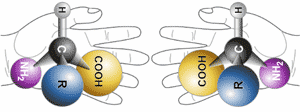
- RNAワールド仮説
- DNAに似ているが、
- 生命の爆発
- 生きている地球
- 地殻は酸化
- Feは陽イオン
- Oは陰イオン
- 光合成
- 劇的な変化
>Top 7. Red Earth: Photosynthesis and the Great Oxidation Event:
- Earth's Age: 10 to 27B years:
- Life has irrevocably transformed Earth's near-surface environment - most conspicuously by the oceans and atmosphere but the rocks and minerals as well oceans.
- It would take more than 1B years, after the innovation of the first living cell.
- >Top Earth's surface changed from dull gray to brick red, with the innovation of photosynthesis.
- Great Oxidation Event; (2.4-1.8B years ago)
- By 2.2B years ago, atmospheric oxygen had risen from zero to more than 1% of its modern level.
- Great Oxidation Event comes from a growing catalog of observations on rocks and minerals; roughly 3.5 to 2.0B years ago.
- Many rocks older than 2.5B years contain minerals that are easily destroyed by oxidation, suggesting an oxygen-free environment.
- Rounded pebble of pyrite and uraninite in ancient streambeds.; such minerals would quickly corrode and break down in today's oxygen-rich environment. (telltale chemistry)
- Rocks younger than 2.5B years contain many unambiguous signs of oxygen.; banded Fe and Mn formations, and oxidized ores of Cu, Ni, U, etc.
- >Top Sulfur isotopes:
- S-32, S-33, S-34, S-36; having 16 protons and 16-20 neutrons in the nucleus.
- All atoms wiggle, but less massive isotopes wiggle more.; in any chemical reaction light isotopes are more likely to jump about than heavy ones (Isotope fractionation)
- In 2000, The fractionation of S-36 to S-32 is almost always twice the fractionation of S-34 to S-32.
- James Farquhar found unexpected change in sulfur isotopes in rocks older than 2.4B years.; saw a radically different fractionation (tenths of a percent)
- S-33 can be selectively affected by ultraviolet (UV) radiation.
- What the sudden change on 2.4B ago? Formation of UV-absorbing properties of ozone.
- More Oxygen:
- Even without photosynthesis, Earth's surface would have experienced a leisurely oxidation through the slow loss of H molecules into space.
- Throughout Earth's history, small amounts of H have been lost, leaving behind a gradual accumulation of excess O.
- Small Mars, has shed much of its water.; most of Mars's near-surface H has escaped to space, while Fe mineral have rusted to give the planet present red color.
- Nitrogen:
- Early in Earth's history, NOX chemicals were produced through reaction of N gas with minerals during lightning storms.
- The newly discovered microbes are able to decompose NOX into N plus O, then use O to burn methane and enjoy a jolt of energy
- >Top Sand Flats of Time:
- Nora Noffke has recognized evidence that microbial mats grew on many of Earth's most ancient sandy shores.
- Three kinds of rock formations:
- Black chert: fine-grained, silica rich microcrystalline or cryptocrystalline sedimentary rock, that may contain small fossils.
- Black shale: fine-grained, clastic sedimentary rock; from the presence greater than 1% carbonaceous material in reducing environment.
- Stromatolites: domelike structure of mineral deposited by early life, binding and cementation of sedimentary grains by biofilms of cyanobacteria.
- Nora Noffke added a fourth rock type; sandstone. Sand is relatively coarse.
- Traces of ancient carbon or concentrations of characteristic minerals could provide a smoking gun for some of the oldest, yet ambiguous, matlike features.
- Mineralogical Explosion:
- Prior to 2.5B years ago, Earth's atmosphere was essentially lacking in O2.
- The rise of photosynthetic microbes caused dramatic cumulative changes between about 2.4 and 2.2B years ago; oxygen rose to greater than 1% of today's concentration.
- 2/3 of 4,500 known mineral species could not have formed prior to the Great Oxidation Event, and the most of Earth's rich mineral diversity probably could not occur on a nonliving world.
- The reasons for this mineralogical dependence on the living world are simple. These beautiful mineral are formed in the shallow crust by the interactions of oxygen-rich waters and preexisting mineral. In the process, new chemical reactions occur for the first time, producing new suits of minerals.
- What of the red planet Mars? The crucial difference is that Mars didn't experience the dynamic circulation of O-rich subsurface waters that produces Earth's astounding m8neral diversity. The little bit of O produced by H loss makes the surface red, like a thin coating of pain a fraction an inch thick.
- >Top Oxygen - a magic transformer:
- Hungry for electrons, O atoms react vigorously with all manner of minerals, thus weathering away rocks and forming nutrient-rich soils in the process.
- O paved the way for life's eventual expansion across the globe.
- Most intimate exchange:
- Every breath we take, a tiny portion of the air becomes a part of us, even as a tiny part of us becomes the air.
- As days pass, our bodies melt away and form again in moment-by-moment chemical reactions with O and other essential elements.
7. 赤い地球: 光合成と大酸化事件
- Life Timline:
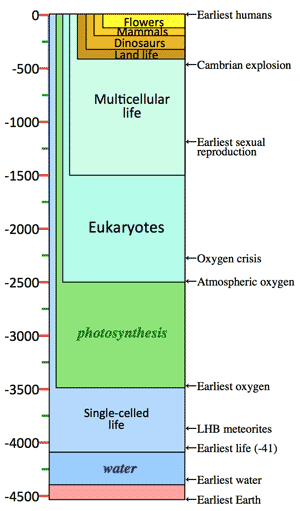
>Top 8. The "Boring" Billion: The Mineral Revolution
- Earth's Age: 2.7 to 3.7B years.
- 'The dullest time in Earth's history seems to have been the Mesoproterozoic.'
- No obvious dramatic transformative events took place.
- The rock record reveals no epic, game-changing impacts or sudden climate perturbations.
- >Top Boring is a risky term:
- Lipids are amazingly diverse, not boring. Lipids divide the insides from the outsides of most living things.
- The point is that boring may speak more to our profound state of ignorance than to any intrinsic dullness.
- Earth's boring billion may be analogous to human civilization's so-called Dark Ages.; the gateway to the modern living world yet once ignored by scholars.
- Hints of dramatic transformations must lie hidden in rocks whose story is largely unread.
- Throughout that billion-year interval, abundant microorganisms - beautifully preserved today as fossils - crowded coastal shallows and offshore environments. Surely we have much to learn about Earth's dark ages.
- Earth wasn't static; Change was incessant, though perhaps not as dramatic as a Moon-forming impact or the Great Oxidation Event.
- The boring billion saw the invention of distinctive processes that formed new types of rocks and valuable ore deposits, as well as the first appearance of many new mineral species.
- Fossil magnetism:
- locked into volcanic rocks.
- ancient magnetic filed frozen into a volcanic rock thus can reveal both N-S orientation and the latitude of the continent when the rocks solidified.
- Sedimentary rocks:
- Different kinds of sediments accumulated in different environments; shallow seas continental shelves, tundra glacial lakes, tidal lagoon and swamps each host a distinct rock type.
- >Top Craton: (<G. strength)
- Earth today preserves three dozen more or less intact cratons, as old as 3.8B years.; that survive as the continents' foundation stones.
- Cratons are the keys - the Rosetta stones of early-Earth history.
- They have been invariably been baked by heat and pressure, altered by the dissolving powers of subsurface waters, and contorted by crustal stresses.
- Younger rocks provide hits about the chronology of craton movements.
- But the oldest ocean crust is not much more than 200M years old.
- Ur is a proposed supercontinent that formed in the Archean 3B years ago.
- Earth was much hotter, tectonic activity was more vigorous than it is today.
- Supercontinent cycle:
- Ancient atmosphere was quite different from that of today.
- O2 was totally absent, while CO2 levels may have been 100-1000 times greater.
- Rain would have fallen as drops of carbonic acid and transformed hard rock to soft clays.
- Rivers carried their muddy cargo into shallow coastal slopes, forming thick delta.
- 2.4B years ago, O2 began to accumulate in the atmosphere.
- Geomagnetic data reveal that divergence of Ur from other cratons.; Newly opened shallow seas between the diverging pieces led to thick deposits of shallow marine sediments.
- Change is the central theme of Earth's story; oceans, atmosphere, surface, deep interior, geosphere and biosphere - all aspects of our planet have changed incessantly over the aeons.
- >Top The Assembly of Rodinia (Родина): (>Fig.)
- The entire supercontinent near the Equator, with Laurentia (most of North America).
- By this model equatorial Rodinia had a hot, dry, desertlike interior.; For almost 250M years,
- the sedimentary rock cycle seemed to have all but shut down.
- Mirovia (Мировая):
- Supercontinent Rodinia must have been surrounded by an even larger superocean, named Mirovia.
- The oceans contain more than 250 times the mass of the atmosphere. Any small change in atmospheric chemistry, takes a very long time to be reflected in the oceans - perhaps about a billion years.
- >Top BIF (Banded Iron Formation):
- either magnetite (Fe3O4) or hematite (Fe2O3), alternating with bands of Fe-poor shales or cherts.; mostly deposited between 2.4 -1.9B years ago.
- 1998, Donald Canfield proposed that sulfur played the major role in Earth's intermediate ocean.; Sulfur dominated Mesoproterozoic ocean.
- The Great Oxidation Event produced enough oxygen to influence many redox sensitive element, including Fe, but not nearly enough to oxygenate the oceans.
- On the other hand, enhanced weathering and oxidation of lots of sulfate into the oceans. Hence the intermediate ocean became enriched in sulfur.
- The influx of sulfate provided an excellent energy source for some microbes.; sulfur-eating microbes produce organic sulfur compounds.
- Nitrogen.
- N2 gas is abundant, 80% of today's atmosphere.
- Life's biochemistry can't use N gas; instead, life requires N in its reduced form, ammonia (NH3).
- Life has evolved a clever enzyme called nitrogenase, that converts N to NH3.
- Nitrogenase enzyme relies on a cluster of atoms containing S plus either Fe or Mo.
- Molybdenum
- Mo is soluble only in O-rich water. During the anoxic time, Mo was to be found near weathering coastlines in shallow water.
- >Top Mineral Evolution:
- Earth's mineralogy has evolved through a sequence of stages; from mineralogical simplicity to complexity, from only a dozen minerals to more than 4500 mineral species.; 2/3 of which could not exist in a nonliving world.
- Cinnabar (HgS):
- is among the least soluble of all ores.
- Any Hg atoms that washed into the ancient sulfitic seas would have immediately reacted with sulfur to form submicroscopic particles of cinnabar, to slowly settle to the bottom.
- Earth has the potential to settle into stasis: a benign balance of its many competing forces.
- Gravity and heat flow, S and O, water and life can maintain a stable equilibrium for hundreds of millions of years.
- and Earth can become unbalanced, reaching a tipping point with consequences difficult to anticipate - rapid changes in a matter of years.
8. 退屈な10億年: 鉱物の革命
- Geomagnetism, 地磁気
- Variation 偏差
- angle between the direction of true geographic north and magnetic pole.
- Dip (Angle of dipression), 俯角
- Earth's magnetic field's inclination and intensity vary at different latitudes; need to be balanced to be level.
- At equator, the dip is close to zero, but at hight latitudes, the dip becomes steeper, and at the poles almost vertical.
- Deviation, 自差
- respone of the compass to local magnetic fields
- Earth's radiogenic heat:
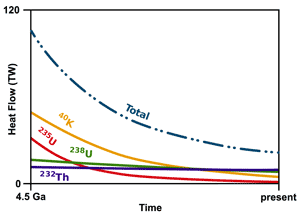
- Assembly of Rodina (Родина):
about 1.2B years ago, Ur, Laurentia, and other Mesoproterooic contenents began to reasseble into a new landmass.
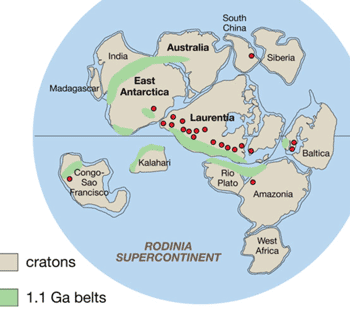
- Partial pressure of O2:
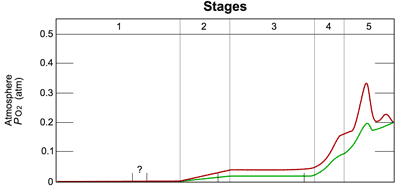
- 3.85-2.45B: anoxic
- 2.45-1.85B O2: in sea, deposited as BIF
- 1.85-0.85B O2: in air and ozone layer formed.
- 0.85-0.54B:
- 0.54-now: accumulated O2 in air
- Magnetite: Fe(Ⅱ)Fe(Ⅲ)2O4
- Mineral Evolution: 鉱物の進化
by Robert M. Hazen, et al.
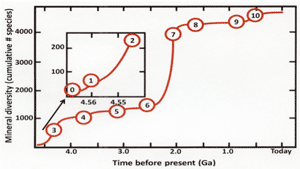
>Top 9. White Earth: The Snowball-Hothouse Cycle
- Earth's Age; 3.7 to 40B years.
- Proterozoic Eon 2.5Ba to 542Ma, spanning almost half of Earth's history.
- The middle billion years - so-called boring billion.
- By contrast, the final 300M years were perhaps most dynamic of all, with continental breakup and assembly, radical climate swings, epic shifts in ocean and atmospheric chemistry, and rise of animal life.
- The boring billion, to the extent that it really was boring, was a consequence of many efficient negative feedbacks that held change in check.
- In spite of the globe-spanning migrations of landmasses and the repeated assembly and breakup of supercontinents during that lengthy interval, Earth's climate seems to have been fairly stable.
- The chemistry of the anoxic, S-rich ocean didn't change much; nor did life evolve in any striking new ways.
- Breakup:
- Beginning about 850Ma, several changes disrupted the former equilibrium and pushed Earth to a climate tipping point.
- The most important was the gradual breakup of equatorial Rodinia.
- About 800Ma, a second small rift zone isolated the West African craton, which moved south from the main landmass. Rodinia's fragmentation was in full swing by 750Ma, a time when extensive chains of volcanoes and basaltic lava flows reveal major cracks in the crust.
- Dynamic sedimentary basins formed in the inter cratonic seas and marked an end to the long hiatus in Earth's rock record.
- Eroded lands contributed mineral nutrients to photosynthetic algae, which had long been limited by the ocean's meager store of PO4, Mo, Mn, and other essential elements.
- Throughout Earth's history, C-rich biomass has been a major consumer of O.
- >Top C isotopes:
- The C in biomass (algae, dead or alive) is always isotopically light compared with inorganic C in limestone.
- In normal times, CO2 inputs and outputs are balanced, but during the Neoproterozoic pulses of rapid algal growth CO2 levels may have dropped, thus reducing greenhouse warming.
- Inland seas mean more evaporation and increase rainfall, which leads to more rapid weathering of exposed rock.
- Rock weathering rapidly consumes CO2, which in turn lead to global cooling.
- >Top Albedo: (<L. albus, white)
- Dry barren land is much more reflective (than ocean).
- Such a juxtaposition of polar oceans and equatorial continents would have exaggerated any global cooling event.
- >Top Snowball Earth: (Neoproterozoic Snowball Earth)
- Glaciers leave an unambiguous suite of sedimentary features (tillite).
- These glacial features in rocks between 740-580Ma just about everywhere they've looked.
- In 1998 Paul Hoffman:
At least twice during that interval, Earth had not just experienced an ice age but had completely frozen over, from poles to equator.
- By contrast, during Earth's most recent ice age, advancing glaciers never go farther south than about 45 degrees latitude, and fossil evidence points to be relatively warm tropical zone even during the maximum extent of ice.
- The white snowball Earth, unable to soak up solar radiation, seemed forever locked in its icy cocoon, as temperatures never rose above freezing.
- How could Earth have possibly recovered from cold global winter?
- White ice and snow could not stop plate tectonics; nor could it slow the incessant exhalation of volcanic gases.
- CO2 once again began to build up in the atmosphere.; eventually to perhaps several hundreds of times modern levels.; a runaway greenhouse effect.
- As the atmosphere warmed, small patches of equatorial ice melted fro the first time in many millions of years.
- As dark land exposed and the oceans cleared of their white coverings; caused Earth to become warmer and warmer.
- Methane clathrate hydrate:
- icelike crystalline mixture of water and gas that forms outcrops on the continental slopes.
- An extreme positive climate feedback might occur when ocean waters warm even slightly, which causes the shallowest clathrate deposits to melt and release copious amounts of methane gas into atmosphere.
- >Top Deep Carbon Observatory:
- C has long been, and continues to be, the central element in our quest for energy.
- C is also the crucial element of life, the core element in the design of new drugs and myriad other products.
- DCO (Deep Carbon Observatory):
- 10 year program to study C in our planet, especially its chemical and biological roles in Earth's deep interior.
- >Top Isopologues:
- are molecules that differ only in their isotopic composition.
- like, light-water (H2O), semi-heavy water (HDO), heavy water (D2O), and super heavy water (T2O)
- Methane, with CH4, come in a variety of isopologues.; 99.8% are C-12, while 1/500 is C-13.
- On Earth, H-to-D ratio is about 1000 to 1.
- This ratios mean that about 1/500 methane molecules holds C-13, while about 4/1000 molecules contain D.
- Cycles of Change:
- The snowball Earth transformed to the hothouse Earth as temperatures soared to record levels.
- The elevated atmospheric concentrations of CO2 gradually fell from their ex trees.
- And for the next 150M years, Earth cycles between these extremes. Not once, not twice, but at least three times the ice gathered and retreated:
- Sturtian glaciation, about 720Ma.
- Marionoan glaciation at 650Ma.
- Gaskiers glaciation at 580Ma.
- As ice retreated, the glaciers left behind huge piles of plucked-up boulders and ground-up rock, lumpy tillites and polished rounded bedrock.
- Soon thereafter thick crystalline deposits of carbonate minerals covered the tillite layers.
- The snowball sealed the ocean, cutting off all O to the ocean water column.
- Meanwhile seafloor hydrothermal vents continued to pump fresh Fe from the mantle into the deep ocean.
- >Top Second Great Oxidation Event:
- Neoproterozoic: world's phosphorite deposits are concentrated in the same time intervals as the snowball-hothouse cycles - northern Canada, Finland, Africa, and India.
- Biology seemed all but irrelevant to geology: Life has influenced geology and geology has influenced life.
- Clay Mineral Factory:
- Rapid postglacial weathering of continents produce significantly more clay minerals than before the three great snowball-hothouse cycles.
- Microbial colonies began to colonize the coastal landscape about this time, and microbes can be especially efficient at turning hard rock into soft clay.
- Burial of C let to the rise of O, which further accelerated the chemical production of clay minerals on land, which led to even more C burial.; hence which contributed to the rise of atmospheric O and the evolution of the modern living world.
- >Top Invention of Animals:
- About 650Ma, multicellular organisms appear in the fossil record, just after the second global snowball glaciation.
- Atmospheric O had risen to near-modern levels. Elevated O has been implicated in the rise of complex multicellular life; active, energy-demanding lifestyles of jellyfish and worms.
- Endosymbiosis: by Margulis
- Life's evolution as driven by symbiosis.
- More than 600Ma, single-celled organisms learned how to cooperate, to congregate, to specialize, and to grow and move in a collective. They learned to become animals.
- Period of dramatic climate change:
- Reflective glacial ice is melting at an accelerating rate.
- Trees are being cut and burned, pumping more CO2 into the atmosphere.
- Accelerating release of CH4 from permafrost and deep ocean ices.
- If Earth's past holds any lessons for our time, the Neoproterozoic's story of sudden climate change should appear at the top of the list.
- For even as its snowball-hothouse shifts opened up new opportunities for evolving life, with each episode of climate reversal, almost every living thing died.
9. 白い地球: 雪だるまと温室の循環
- Snowball Earth: by Powell, 2001
Snowball in 750Ma
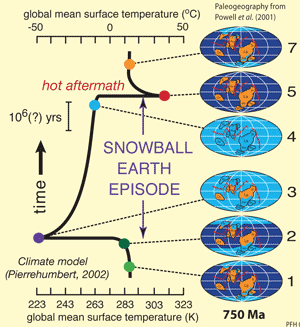
- Note abrupt onset and termination of glaciation at low latituds, and the hot aftermath due to CO2.
- a
- スノーボール地球
>Top 10. Green Earth: The Rise of the Terrestrial Biosphere:
- Earth's Age: 4.0 to 4.5B years (the last 542M years)
- Plate tectonics saved Earth from itself.
- Continental masses shifted poleward, liberating the Equator from ice accumulating lands, moderating the extreme snowball-hothouse cycle.
- Abundant new photosynthetic algal life helped buffer the wild fluctuations of CO2.
- During 542Ma, continents have continued to shift, first closing one ocean to form yet another great supercontinent, then breaking up to form the still-widening Atlantic Ocean.
- Climate has fluctuated from hot to cold and back again many times, thought not to the snowball-hothouse extremes of Neoproterozoic.
- Exquisitely preserved fossils; teeth, shells, bones, and wood.
- Animals and plants turn out to be particularly sensitive to changes in Earth's environment.; Animals and plants respond to Earth's cycles quickly - they evolve fast or they die. As old species die out, new species take their places.
- Shifting continents of the past 550M years continued to provide changeable stage for evolution of Earth.
- >Top Act-1:
- The beginning of Cambrian Period (542Ma):
- Supercontinent of Rodinia broken into several large pieces.; Gondwana stretching from south pole to beyond the equator.
- Laurentia (including today North America, Greenland and much of Europe)
- Over the next 250M years, plates move northward. Laurentia by merging first with what would become Europe, then with a significant part of Siberia.
- >Top Act-2:
- 300Ma, northward tracking Gondwana collided with Laurentia to form the most recent supercontinent, Pangaea.; closing of the ancient sea between North America and Africa, a collision that birthed the Appalachian Mountains. (soared 9-10Km high)
- 3/4 of it located in the southern hemisphere.
- Superocean surrounded Pangaea was Panthalassa (<G. all sea)
- Act-3:
- 175Ma, the opening of Atlantic Ocean.
- First, Laurentia and Gondwana fractured
- Antarctica and Australia split off Gondwana and moved south.
- A rift between South America and west coast of Africa opened South Atlantic, while India broke off the east coast of Africa, and began northward, ultimately smash into Asia and crumple up the Himalayan Mountains.
- Life evolved in harsh competition on larger landmasses, but evolution proceeded independently on isolated continents.
- Locations of mountain ranges and oceans altered climate.
- Animal Explosion:
- For the first time, green photosynthetic algae evolved to achieve a firm footing on swampy land; the continent were looking green at the edges.
- As atmospheric O soared in concentration, so did ozone layer - the radiation barrier.
- For 40M years, multicellular jelly fish and worms appear to have dominated the postglacial oceans.; rarely preserved in the fossil record.
- 530Ma, a striking evolutionary trick; many types of animals learned to build their own protective shells out of hard minerals (CaCO3 or SiO2).
- >Top Cambrian explosion:
- Explosion is a misleading moniker; it took many millions of years for 'biomineralization' to catch on.
- 580Ma, a few sponges with hardened spines appeared.
- 550Ma, the tail end of Ediacaran Period, a variety of wormlike creatures learned to craft carbonate minerals into tubeshaped protective homes on the ocean floor.
- 535Ma, the first recognizable shelly fauna appeared.
- >Top 530Ma, the real explosion occurred, when all manner of shelled animals suddenly came on the scene.
- An evolutionary arms race ensued. Armored predators and armored prey assumed larger and larger dimensions. Teeth and claws arose, bony protective plating and sharp defensive spine.
- Eyes became mandatory in the cutthroat world.
- Their carbonate bioskeletons contributed to massive limestone layers.
- 521-250Ma: wide-eyed sea creatures called trilobites are the most prized.
- Stephen Jay Gould 'Wonderful Life'; discovered at the Burgess Shale in BC, 505Ma site.
- Rhynie plant:
- leafless plants - the ancestors of our green world.
- >Top Prototaxites: appeared 420-379Ma.
- diameter 1m, and height reaching 8m, largest known living thing on land; a giant fungus, or largest toadstool in Earth's. history, having green stems and green branches but no leaves; a few small insects and spiderlike animals.
- For the first time in history, Earth's land was emerald green.
- >Top Mycorrhiza:
- Root systems evolved in remarkable ways as well.; new symbiotic relationships between plant roots and fungal filaments called mycorrhiza.
- This astonishing evolutionary strategy affects great majority of plants.
- The mycorrhizal fungi efficiently extract phosphate and other nutrients from the soil and pass them to the plant, which in turn provides the fungi with a steady diet of energy-rich glucose ad other carbohydrates.
- Animals' profound evolutionary advances:
- Invertebrates:
- Insects, spiders, worms, and other small creatures were the first terrestrial explorers.
- Vertebrates:
- 500Ma, primitive jawless fish,
- 420Ma, armored fish with bony-plated jaws.
- 400Ma, cartilaginous sharks and bony fish appeared.
- 397Ma, evolutionary transition from fins to four-footed land animals.
- 375Ma, four-legged land animal
- 340Ma, first true amphibians appeared (middle of Carboniferous)
- >Top Amphibian:
- characterized by broad, flat skulls, splayed legs, five-toed feet, ears suited for listening in air, and other terrestrial adaptations, were clearly different from their fish ancestors.
- Climate waxed and waned, droughts and floods stressed he land, and the odd asteroid impact and super volcano eruption.
- But Earth and its biota have proven unfailingly resilient to such insults. Life always finds a way to adapt to the reality of now.
- Third Great Oxidation Event:
- 300Ma, Earth forests were flourishing, and buried C-rich black coal.
- The rise in O2 was gradual, from 18% of 380Ma, to 25% 350Ma, to remarkable 30% 300Ma.
- Ancient atmospheric bubbles in Carboniferous-age amber still hold 30% or more O2.
- Most dramatic were the giant insects; monster dragonflies with 70cm wingspans. The increase O2 also enhanced atmospheric density and made flying and gliding that much easier.
>Top Mass Extinctions:
- 251Ma: the end of Permian, Paleozoic Era witnessed the greatest mass extinction.; 70% of land species and whopping 96% of marine species vanished - called the Great Dying.
- Never before or since in Earth history have so many creatures disappeared forever.
- What caused the Great Dying; like a giant steroid impact; indeed, multiple reinforcing stress factors might have come into play.
- O2 level rapidly dropped; from 35% to 20%.
- global cooling and a modes ice age, with thick ice covering the south portions of Pangaea.
- large drop in ocean levels exposing continental shelves, which are most productive biosphere.
- Large-scale volcanism at the end of Paleozoic Era.
- Depleted the ozone layer, opening the windows for mutagenic UV radiation.
- >Top Dinosaurs:
- 230 - 66Ma; Dinosaurs came on the scene as beneficiaries of the end-Paleozoic mass extinction (P-Tr), developed through (Tr-J) and became extinct at (K-T).
- These reptiles stared slow and small but diversified and radiated into ecological niche.
- Another significant extinction event (Tr-J) wipe out most nondinosaur vertebrates.; A dinosaur explosion followed.
- Mesozoic Era saw many important biological development; ammonite evolved.
- Pangaea began to break up, and the Atlantic Ocean was born.
- O2 rebounded to the present value of 21%.
- 65Ma; one of the worst days in Earth history. an asteroid about 10km in diameter collided with Earth near Yucatán Peninsula; followed by massive fires, immense clouds of vaporized rock darkened the skies and all but shut down photosynthesis.
- All dinosaurs except for one minor lineage - birds - went extinct. Ammonites also died out.
- Mammals: evolving small, rodentlike, footed in almost every ecological niche.
- Were there no mass extinction prior to 540Ma?
- There are almost no diagnostic fossils to record.
- Certainly life was severely challenged during the snowball Earth, perhaps during earlier glaciations. There cold have been hundreds of mass extinctions stretching back to the very dawn of life.
- Human Age:
- More than 99.9% of Earth's existence, there were no humans.
- Within a few million years of the dinosaurs' demise, mammals had radiated into vacant ecological niches. Many of these strange and wonderful new mammals died in other mass extinctions 56, 37, 34Ma.
- We all point to a common primate ancestor about 30Ma.
- The first hominids who walk erect, arose perhaps 8Ma in central Africa.
- Perhaps 8 separate times in the past 3M years, ice has spread from the poles reaching as far south as the upper Midwest. Ice bridges linked Asia and North America.
- Cold temperature favor the survival of infants who stay close to their mothers for longer periods, as well as infants with bigger heads. Big heads mean big brains.
- Warm interglacial periods, great retreats of seas followed by equally great advances. Such cycles were for the most part merciful; nomadic humans had plenty of time to move and survive.
- Aeons ago rocks, water, and air made life. Life, in turn, made the atmosphere safe to breath and made the land green and safe to roam. Life turned the rocks into soils that have nurtured more life and become home to an ever-widening array of flora and fauna.
- Throughout Earth history, air, seas, land, and life have been shaped by Earth's transformative powers; the power of sunlight and Earth's inner heat, the magic of water, the chemical power of C and O, and s¥ceaseless convention of the deep interior and consequent disruptions of the crust through earthquakes, volcanoes, and shifting continental plates
10. 緑の地球: 地表生物圏の登場
- Pangaea:

- Last Continental Drift:
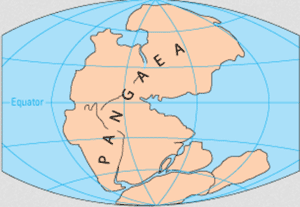 Per
Per
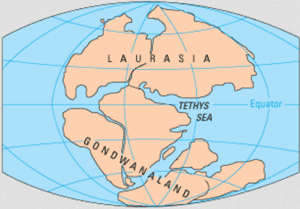 Tri
Tri
 Jur
Jur
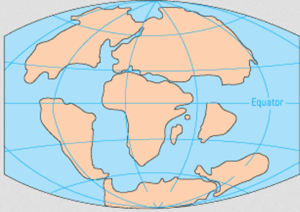 Cre
Cre
- Trilobite: 521-250Ma PT
diappeared in PT
mass extinction
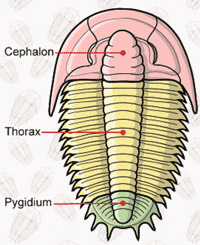
- Prototaxites, a giant fungus
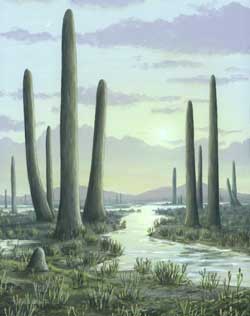
- 菌従属栄養植物
- 地質年代
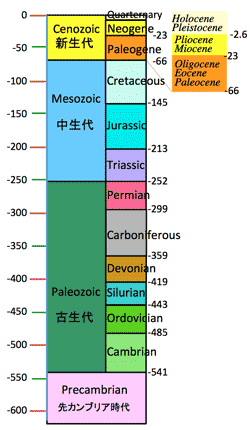
- Mass Extinctions:
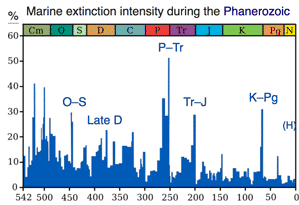
- 450-440Ma, O-S: Ordovician-Silurian extinction
- 375-360Ma, Late-D: Late Devonian extinction
- 252Ma, P-Tr: Permian-Triassic extinction
- 201.3Ma, Tr-J: Triassic-Jurassic extinction
- 66Ma, K-T: Cretaceous-Paleogene extincntion, Chicxulub impact
- 10K - ongoing, Holocene extinction; by possible causes of humans.
>Top 11. The Future: Scenarios of a Changing Planet:
- Earth's Age: The next 5B years
- As in the past, Earth will continue to be a planet of change:
- Climate, ice ages, plate tectonics, giant asteroid impacts and megavolcanoes will once again disrupt life.
- But other changes will be new; as irreversible as the first granite crust. Myriad living species will die out, never to be seen again.
- Tigers, polar bears, humpback whales, panda, gorillas - all are doomed. It's very possible that humans will die out, too.
- Endgame: 5B years from now:
- Sun has shone steadily, getting slightly brighter. Eventually H will run out. Had the Sun been such a red dwarf star, Earth's ultimate fate would be to freeze solid.
- Life, if it survived at all, would be limited to a few hardy microbes deep underground, where liquid water cold persist.
- Sun has persisted for 4.5B years and will continue to persist for about 5B more.
- Sun will swell to more than 100 times its present diameter - even past the orbit of Earth.
- Scenario-1: Red giant Sun will simply overwhelm Earth.
- Scenario-2: As the Sun becomes less massive, Earth's orbit will move outward - perhaps just enough to avoid being engulfed. Sparse subsurface microbial ecosystems may preserve for another billion years, but never again will the land be lush and verdant.
- Desert World: 2B years from now.
- 4.5B years ago, the Sun shone with 70% of its present light.
- 2.4B years ago, the Great Oxidation Event, Sun shining with 85%
- and a billion years from now, the Sun will be brighter still. More heat means more evaporation, which produces more clouds, which reflects more sunlight back into space. More heat means faster weathering of rocks, which consumes more CO2, which lowers the amount of greenhouse gases. Such negative feedback loops may keep Earth habitable for a long time.
- But there will come a tipping point. Earth's oceans will evaporate. No ice caps or glaciers will remain.
- But as the Sun continues to warm and more water vapor enters the atmosphere, H will be lost to space, slowly dying out the planet. Earth's surface will be barren and baked; life will be on the precipice.
- >Top Novopangaea or Amasia: 250M years from now.
- Plate tectonics will continue to play a central role in changing Earth.
- Most of Earth's land will again form one giant supercontinent - Novopangaea.
- Atlantic will have widened, while Pacific will have shrunk.
- Australia will have moved north toward South Asia.
- Antarctica will have shifted away from the South Pole, also in the direction of South Asia.
- Africa is inching northward to close off the Mediterranean Sea, will have collided with southern Europe.
- Novopangaea is projected to be one immense landmass.
- Everyone agrees that Earth's geography 250m years from now, while strikingly different from today, will echo past times.
- Transient collection of continents at the Equator will reduce the impacts of ice ages and moderate change in sea levels.
- Mountains will rise where continents collide.
- Atmospheric levels of CO2 and O2 fluctuate.
- Impact: the net 50M years:
- Death rate by asteroid impact: 1/100,000
- But in the next 50M years al least one big hit.
- Death rate by lightning: 1/60 per year
- Megavolcano: the next 100K years:
- Volcanoes have no apparent upper limit in size.
- Geological record holds evidence of eruptions 100 times greater than the largest volcanic events in human history.
- 1M sq.km of basalt flows occurred in Siberia 251Ma.
- Ice factor: the next 50K years:
- During global cooling, more than 5% of Earth's water can be frozen solid, the oceans become significantly enriched in O-18. During global warming, O-18 levels in ocean decline.
- Sea levels will continue to vary dramatically, with many more rises and falls.
- Warming; the next 100 years:
- Most of us focus on short-term concerns;
- Over the next 100 years, the consequences of this warming will affect many people in many different ways.
- Global temperature rise of just a couple of degrees could trigger extinction rates among birds 40% in Europe and exceeding 70% in the rain forest of northeastern Australia.
- Warming can have other paradoxical effects.
- The Gulf Stream is powered by the strong temperature difference between the Equator and higher latitudes. If global warming reduces the temperature contrast, then the Gulf Stream may weaken or even stop.
- Other ocean currents would be similarly affected.
- As ice melts, the seas rise. Such a sea change will affect many coastal residents around the world
- >Top PERM (Paleocene-Eocene Thermal Maximum), occurred around 56Ma, is the most recent event that we can compare today's warming to. The global warmed 5-9ºC.
- Sudden disappearance of thousands of species.
- Even the extinction of these great beasts is but a temporary loss to Earth. New great and wondrous beasts will inevitably evolve in a geological moment to fill those vacant niches.
11. 未来へ: 変わりゆく惑星のシナリオ
- 2.5億年後:
- Future Plate Tectonics:
- +50M years from now:
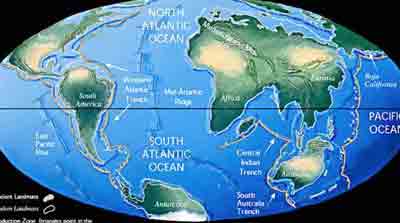
- +150M years from now:
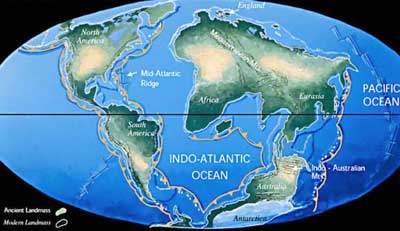
- +250M years from now:
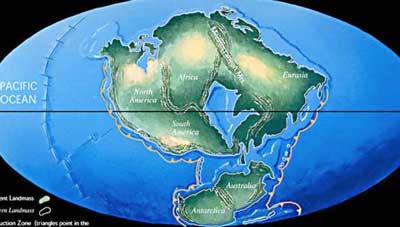
- Future of the Sun:
Luminosity/Radius/Temperature
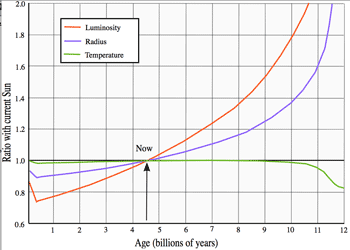
- 5000万年後
- 10万年後
- 5万年後
- 100年後
Comment
- >Top Why there are Nobel Prizes in physics, chemistroy and biology but not in geology?
- Geology coupled with related other areas of science is rapidly evolving area to clarify the history of Earth and Life, and preparing answers for the fundamental question of Paul Gauguin; "D'où venons-nous? Que sommes-nous? Où allons-nous?"

 |
The Story of Earth- The fist 4.5B years, from stardust to living planet -
|
Cat: SCI |
Robert M. Hazen |
16y12u/18227r |
Résumé |
Remarks |
>Top 0. Introduction:
|
0. 序文:
|
>Top 1. Birth: the formation of Earth:
|
1. 地球の生成:
|
>Top 2. The Big Thwack: The formation of the Moon
|
2. 大衝突: 月の生成
|
>Top 3. Black Earth: The First Basalt Crust:
|
3. 黒い地球: 最初の玄武岩地殻
|
|
|
>Top 4. Blue Earth: The Formation of the Oceans
|
4. 青い地球: 大洋の生成
|
>Top 5. Gray Earth: The First Granite Crust:
|
5. 灰色の地球: 最初の花崗岩地殻:
|
>Top 6. Living Earth: The Origins of Life:
|
6. 生きている地球: 生命の起源:
|
>Top 7. Red Earth: Photosynthesis and the Great Oxidation Event:
|
7. 赤い地球: 光合成と大酸化事件
|
>Top 8. The "Boring" Billion: The Mineral Revolution
|
8. 退屈な10億年: 鉱物の革命
|
>Top 9. White Earth: The Snowball-Hothouse Cycle
|
9. 白い地球: 雪だるまと温室の循環
|
>Top 10. Green Earth: The Rise of the Terrestrial Biosphere:
|
10. 緑の地球: 地表生物圏の登場
|
>Top 11. The Future: Scenarios of a Changing Planet:
|
11. 未来へ: 変わりゆく惑星のシナリオ
|
Comment |
|
 |